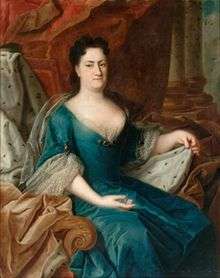Melusine von der Schulenburg, Duchess of Kendal
| Melusine von der Schulenburg | |
|---|---|
 | |
| Born |
25 December 1667 Emden, Magdeburg |
| Died | 10 May 1743 (aged 75) |
| Title | Duchess of Kendal and Munster |
| Children |
Luise Sophie von der Schulenburg Melusina von der Schulenburg Margarethe Gertrud von Oeynhausen |
| Parent(s) |
Gustavus Adolphus Baron von der Schulenberg Petronelle Oddie de Schwenken |
Ehrengard Melusine von der Schulenburg, Duchess of Kendal, Duchess of Munster (25 December 1667 – 10 May 1743) was a long-time mistress to King George I of Great Britain.
Early life
She was born at Emden in the Duchy of Magdeburg. Her father was Gustavus Adolphus, Baron von der Schulenburg,[1] Privy Councillor to the Elector of Brandenburg, by his wife Petronelle Oddie de Schwenken and a sister to Federic Achatius, Count von der Schulenburg and Hehlen.[2] Her brother was Marshal Johann Matthias von der Schulenburg, and the early feminist Dorothea von Velen was her first cousin. Her middle name was probably given in reference to the Melusine legends.
Royal mistress
When a Maid of Honour to the Electress Sophia of Hanover, she became a royal mistress of the Electoral Prince, George Louis. George Louis succeeded as Elector of Hanover in 1698 and King of Great Britain (as George I) in 1714.
Melusine moved with him to England, and on 18 July 1716 was created for life Duchess of Munster, Marchioness of Dungannon, Countess of Dungannon and Baroness Dundalk, in the Peerage of Ireland. On 19 March 1719 she was further created Duchess of Kendal, Countess of Feversham and Baroness Glastonbury, in the Peerage of Great Britain.[3] In 1723, Charles VI, Holy Roman Emperor, created her Princess of Eberstein. This last creation in particular tended to support the theory that she had married the King in secret.[4] Robert Walpole said of her that she was "as much the queen of England as anyone was"[5] (George's wife Sophia had been kept in imprisonment since their divorce in 1694).
The Duchess of Kendal was a very thin woman, being known in Germany as "the Scarecrow" and in England as "the Maypole". The Jacobites referred to her as "the Goose," most famously in the taunting Scots ballad Cam Ye O'er Frae France. When in England, she lived principally at Kendal House in Isleworth, Middlesex.[6]
She bore him three illegitimate children:[7][8]
- Anna Luise Sophie von der Schulenburg, Countess of Dölitz (1692–1773), who married Ernest August Philipp von dem Bussche zu Ippenburg.
- Petronilla Melusina von der Schulenburg (1693–1778), who married Philip Stanhope, 4th Earl of Chesterfield, a leading Whig politician.
- Margarethe Gertrud von Oeynhausen (1701–1726), who married Albrecht Wolfgang, Count of Schaumburg-Lippe.
Luise Sophie and Petronilla Melusina were officially acknowledged as the children of Melusine's sister Gertrud (1659–1697) and her husband Friedrich Achaz von der Schulenburg (1647–1701), who was a kinsman of the sisters and thus shared the same surname. Margarethe Gertrud was officially named von Oeynhausen because she was recognised as the daughter of Melusine's other sister, Sophia Juliane von Oeynhausen (1668–1755).[9]
Later life and death

After George's death, she kept a raven she believed to be the dead king.[10] She died, unmarried (unless George I had wedded her), on 10 May 1743.
See also
References
- ↑ Lundy, Darryl. "p. 10507". The Peerage. External link in
|publisher=(help) Retrieved 3 August 2010 - ↑ marquis de Ruvigny, Melville Henry Massue (2000). The Nobilities of Europe. The Nobilities of Europe: Adamant Media Corporation. p. 380. ISBN 1402185618.
- ↑ "Mistress of George I and his questionable mouthpiece". HISTORICAL FIGURES FOUNDATION.
- ↑ "Enter the Hanoverians". 2 May 2010. Retrieved 17 March 2012.
- ↑ "The Monarch and the Maypole".
- ↑ "the Duchess of Kendal".
- ↑ "Enter the Hanoverians". 2 May 2010. Retrieved 17 March 2012.
- ↑ "Children and descendants of George I, King of Great Britain".
- ↑ Kilburn, Matthew (2004; online edition January 2008) "Schulenburg, (Ehrengard) Melusine von der, suo jure duchess of Kendal and suo jure duchess of Munster (1667–1743)", Oxford Dictionary of National Biography, Oxford University Press, doi:10.1093/ref:odnb/24834 (subscription or UK public library membership required)
- ↑ Deary, Terry. Cruel Kings and Mean Queens. London: Scholastic, 1995. p. 42.
External links
- Lundy, Darryl. "p. 10507". The Peerage. External link in
|publisher=(help)
|